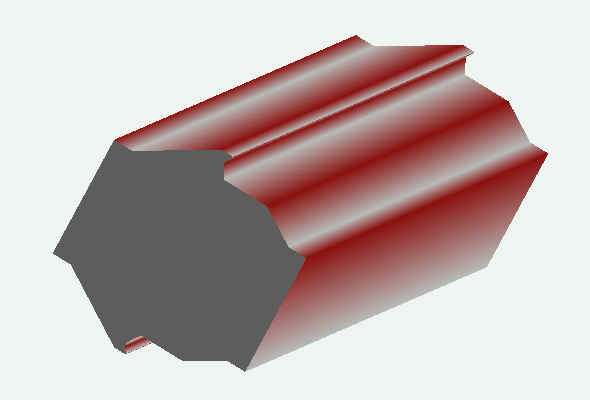
| library: libGraf3d #include "TXTRU.h" |
| Inheritance Chart: | |||||||||||||||||||||||
|
private:
void DumpPoints(int npoints, float* pointbuff) const
void DumpPolygons(int npolygons, int* polybuff, int buffsize) const
void DumpSegments(int nsegments, int* segbuff) const
protected:
void CheckOrdering()
public:
TXTRU()
TXTRU(const Text_t* name, const Text_t* title, const Text_t* material, Int_t nyx, Int_t nz)
TXTRU(const TXTRU& xtru)
virtual ~TXTRU()
static TClass* Class()
virtual void Copy(TObject& xtru) const
virtual void DefineSection(Int_t secNum, Float_t z, Float_t scale = 1., Float_t x0 = 0., Float_t y0 = 0.)
virtual void DefineVertex(Int_t pointNum, Float_t x, Float_t y)
virtual Int_t DistancetoPrimitive(Int_t px, Int_t py)
virtual Int_t GetNxy() const
virtual Int_t GetNz() const
virtual Float_t GetOutlinePointX(Int_t pointNum) const
virtual Float_t GetOutlinePointY(Int_t pointNum) const
virtual Float_t* GetScale() const
virtual Float_t GetSectionScale(Int_t secNum) const
virtual Float_t GetSectionX0(Int_t secNum) const
virtual Float_t GetSectionY0(Int_t secNum) const
virtual Float_t GetSectionZ(Int_t secNum) const
virtual Float_t* GetX0() const
virtual Float_t* GetXvtx() const
virtual Float_t* GetY0() const
virtual Float_t* GetYvtx() const
virtual Float_t* GetZ() const
virtual TClass* IsA() const
TXTRU& operator=(const TXTRU& rhs)
virtual void Paint(Option_t* option)
virtual void Print(Option_t* option) const
virtual void SetPoints(Double_t* buff)
virtual void ShowMembers(TMemberInspector& insp, char* parent)
virtual void Sizeof3D() const
void SplitConcavePolygon(Bool_t split = kTRUE)
virtual void Streamer(TBuffer& b)
void StreamerNVirtual(TBuffer& b)
virtual void TruncateNxy(Int_t npts)
virtual void TruncateNz(Int_t npts)
protected:
Int_t fNxy number of x-y points in the cross section
Int_t fNxyAlloc number of x-y points allocated
Int_t fNz number of z planes
Int_t fNzAlloc number of z planes allocated
Float_t* fXvtx [fNxyAlloc] array of x positions
Float_t* fYvtx [fNxyAlloc] array of y positions
Float_t* fZ [fNzAlloc] array of z planes
Float_t* fScale [fNzAlloc] array of scale factors (for each z)
Float_t* fX0 [fNzAlloc] array of x offsets (for each z)
Float_t* fY0 [fNzAlloc] array of y offsets (for each z)
TXTRU::EXYChecked fPolygonShape CCW vs. CW, convex vs. concave
TXTRU::EZChecked fZOrdering increasing or decreasing
Bool_t fSplitConcave
public:
static const TXTRU::EXYChecked kUncheckedXY
static const TXTRU::EXYChecked kMalformedXY
static const TXTRU::EXYChecked kConvexCCW
static const TXTRU::EXYChecked kConvexCW
static const TXTRU::EXYChecked kConcaveCCW
static const TXTRU::EXYChecked kConcaveCW
static const TXTRU::EZChecked kUncheckedZ
static const TXTRU::EZChecked kMalformedZ
static const TXTRU::EZChecked kConvexIncZ
static const TXTRU::EZChecked kConvexDecZ
static const TXTRU::EZChecked kConcaveIncZ
static const TXTRU::EZChecked kConcaveDecZ

XTRU is an poly-extrusion with fixed outline shape in x-y,
a sequence of z extents (segments) and two end faces perpendicular
to the z axis. The x-y outline is defined by an ordered list of
points; the overall scale of the outline scales linearly between
z points and the center can have an x-y offset specified
at each segment end.
A TXTRU has the following parameters:
- name name of the shape
- title shape's title
- material (see TMaterial)
- nxy number of x-y vertex points constituting the outline --
this number should be at least 3
- nz number of planes perpendicular to the z axis where
the scaling dimension of the section is given --
this number should be at least 2
- Xvtx array [nxy] of X coordinates of vertices
- Yvtx array [nxy] of Y coordinates of vertices
- z array [nz] of z plane positions
- scale array [nz] of scale factors
- x0 array [nz] of x offsets
- y0 array [nz] of y offsets
Author: R. Hatcher 2000.04.21
All XTRU shapes are correctly rendered in wire mode but can encounter
difficulty when rendered as a solid with hidden surfaces. These
exceptions occur if the outline shape is not a convex polygon.
Both the X3D and OpenGL renderers expect polygons to be convex.
The OpenGL spec specifies that points defining a polygon using the
GL_POLYGON primitive may be rendered as the convex hull of that set.
Solid rendering under X3D can also give unexpected artifacts if
the combination of x-y-z offsets and scales for the segments are
chosen in such a manner that they represent a concave shape when
sliced along a plane parallel to the z axis.
Choosing sets of point that represent a malformed polygon is
not supported, but testing for such a condition is not implemented
and thus it is left to the user to avoid this mistake.

TXTRU shape - default constructor
TXTRU shape - normal constructor Parameters of Nxy positions must be entered via TXTRU::DefineVertex Parameters of Nz positions must be entered via TXTRU::DefineSection
TXTRU copy constructor
TXTRU destructor deallocates arrays
TXTRU Copy method
Set z section iz information expand size of array if necessary
Compute the distance from point px,py to a TXTRU by calculating the closest approach to each corner
Paint this 3-D shape with its current attributes
Dump the info of this TXTRU shape
Option: "xy" to get x-y information
"z" to get z information
"alloc" to show full allocated arrays (not just used values)
Create TXTRU points in buffer order as expected by other methods (counterclockwise xy, increasing z)
Return total X3D needed by TNode::ls (when called with option "x")
(Dis)Enable the splitting of concave polygon outlines into multiple convex polygons. This would make for better rendering in solid mode, but introduces extra, potentially confusing, lines in wireframe mode. *** Not yet implemented ***
Determine ordering over which to process points, segments, surfaces so that they render correctly. Generally this has to do with getting outward normals in the hidden/solid surface case.
Dump the vertex points for visual inspection
Dump the segment info for visual inspection
Dump the derived polygon info for visual inspection
TXTRU& operator=(const TXTRU& rhs)
Int_t GetNxy() const
Int_t GetNz() const
Float_t* GetXvtx() const
Float_t* GetYvtx() const
Float_t* GetZ() const
Float_t* GetScale() const
Float_t* GetX0() const
Float_t* GetY0() const
TClass* Class()
TClass* IsA() const
void ShowMembers(TMemberInspector& insp, char* parent)
void Streamer(TBuffer& b)
void StreamerNVirtual(TBuffer& b)